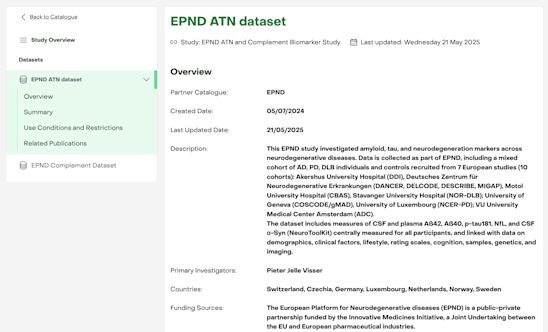ATN biomarker dataset
05/22/2025

What is the ATN biomarker dataset?
The ATN dataset is the first biomarker case study released by the European Platform for Neurodegenerative Diseases (EPND). It comprises harmonised biomarker, clinical, imaging, and genetic data from over 350 participants. The dataset integrates a wide range of variables relevant to Alzheimer’s disease (AD), Parkinson’s disease (PD), and dementia with Lewy bodies (DLB), enabling researchers to investigate shared pathological mechanisms across these conditions.
How was the dataset generated?
The dataset draws on biosamples and clinical data contributed by ten European cohorts. Centralised analyses conducted by the University of Gothenburg employed Roche’s NeuroToolKit to quantify cerebrospinal fluid (CSF) and plasma biomarkers, including Aß42, Aß40, p-tau181, neurofilament light chain (NfL), and CSF α-synuclein. Data harmonisation and analytical workflows were carried out at the University of Maastricht.
In addition to biomarker profiles, the dataset includes detailed information on demographics, genetics, clinical assessments (cognition, motor function, mood), and imaging. This makes the ATN dataset a valuable resource for understanding the heterogeneity and overlap of neurodegenerative diseases.
Which cohorts were involved in the ATN biomarker case study?
The ATN biomarker case study was led by Pieter-Jelle Visser, Professor in Molecular Epidemiology of Alzheimer's Disease at the University of Maastricht. The case study involved researchers and cohorts based in seven countries (Denmark, Germany, Czechia, Norway, Switzerland, Luxembourg, and the Netherlands), at the following institutions: Akershus University Hospital (DDI cohort), Deutsches Zentrum für Neurodegenerative Erkrankungen (DANCER, DELCODE, DESCRIBE, MIGAP cohorts), Motol University Hospital (CBAS cohort), Stavanger University Hospital (NOR-DLB cohort); University of Geneva (COSCODE/gMAD cohort), University of Luxembourg (NCER-PD cohort); Amsterdam UMC (ADC cohort).
Information on all these studies and cohorts can be found on the EPND Hub.
What are the findings from the ATN biomarker case study?
Findings presented at the 2024 Alzheimer’s Association International Conference suggest the presence of Alzheimer’s-related amyloid and tau pathology in individuals with DLB and, to a lesser extent, PD. A notable correlation between p-tau181 and α-synuclein across disease categories suggests converging pathological pathways, with implications for biomarker-led diagnosis and future clinical trial design.
How can researchers access and analyse the ATN dataset?
The ATN dataset is accessible through the EPND Hub, a secure platform designed to facilitate data and biosample discovery, access, and analysis. Through EPND's interoperability with the Alzheimer’s Disease Data Initiative’s AD Workbench, registered users can analyse data securely in personal, cloud-based workspaces using a unified login.
What is the EPND Hub and how can it support collaborative research?
The EPND Hub provides researchers with tools to search, filter, and visualise neurodegenerative disease datasets and biosamples, including the ATN biomarker dataset. It supports secure collaboration, federated data access, and advanced analysis, through its interoperability with the AD Data Initiative's AD Workbench. Its ELSI Support Desk helps researchers to navigate ethical and legal considerations whilst collaborating via the Hub, providing guidance on data protection, research ethics and contractual arrangements. The Hub currently includes metadata on 100+ research studies across 12 disease areas and 25 countries, representing over 265,000 research participants.
Click here to access the ATN biomarker dataset listing on the EPND Hub.